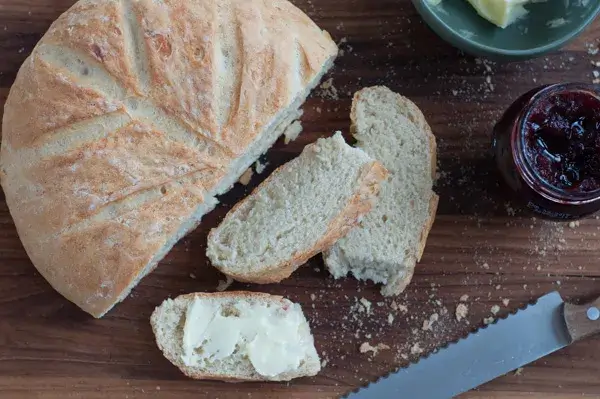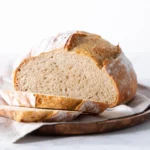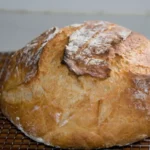Looking to bake a delicious loaf of artisan bread at high altitude? You’re in luck!
This article provides you with the tips and tricks you need to conquer the challenge of baking bread in the mountains.
From adjusting the recipe to perfecting your techniques, we’ve got you covered. Say goodbye to flat and dense loaves, and say hello to light and fluffy bread that will have you craving more.
Get ready to elevate your bread baking game!
Contents
- 1 Key Takeaways
- 2 The Science of Baking at High Altitudes
- 3 Essential Ingredients for High Altitude Artisan Bread
- 4 Adjusting the Recipe for Altitude: Tips and Tricks
- 5 The Perfect Techniques for High Altitude Bread Baking
- 6 Troubleshooting Common High Altitude Bread Baking Issues
- 7 Frequently Asked Questions
- 7.1 Can I Use Regular Bread Flour Instead of High Altitude Bread Flour?
- 7.2 How Do I Adjust the Amount of Yeast in the Recipe for High Altitude Baking?
- 7.3 Can I Use a Bread Machine to Make High Altitude Artisan Bread?
- 7.4 How Long Should I Let the Dough Rise at High Altitudes?
- 7.5 Can I Use a Different Type of Sweetener in the Recipe Instead of Sugar?
- 8 Can the Artisan Bread Recipe be Adjusted for High Altitude Baking?
- 9 Conclusion
Key Takeaways
- High altitude baking challenges include lower air pressure, quicker rising and collapsing of baked goods, and faster drying out of baked goods.
- Essential ingredients for high altitude artisan bread include yeast labeled for high altitude baking and flour with higher protein content.
- Adjustments for high altitude baking include reducing rising times, experimenting with different flours, increasing hydration, and adjusting oven temperature and baking time.
- Perfect techniques for high altitude bread baking include using high altitude bread flour, decreasing yeast proofing time, and ensuring proper rise before moving on to the next step.
The Science of Baking at High Altitudes
To bake successfully at high altitudes, you need to understand the science behind it. Altitude effects can have a significant impact on the baking process, creating a unique set of challenges.
At higher altitudes, the air pressure is lower, which means that the boiling point of water is lower as well. This affects the way ingredients behave, particularly when it comes to moisture and leavening agents.
The lower air pressure can cause baked goods to rise more quickly and then collapse, resulting in dense and sunken cakes or breads. Additionally, the drier air at high altitudes can cause baked goods to dry out more quickly, leading to a shorter shelf life.
Understanding these altitude effects and the specific baking challenges they present is crucial for achieving successful results in high altitude baking.
Essential Ingredients for High Altitude Artisan Bread
For successful high altitude artisan bread, the key ingredients are stability and adaptability. When it comes to high altitude yeast selection, it’s important to choose a yeast that can withstand the unique challenges of baking at higher elevations. Look for yeast specifically labeled for high altitude baking, as it will have a higher tolerance for the lower air pressure and moisture levels found at higher altitudes.
As for high altitude flour recommendations, opt for a flour with a higher protein content. This will help strengthen the gluten structure, resulting in a better rise and texture for your bread. Whole wheat flour and bread flour are good options to consider.
Adjusting the Recipe for Altitude: Tips and Tricks
Make adjustments to your bread recipe for high altitude baking using these helpful tips and tricks:
- Adjust rising times: At high altitudes, the air pressure is lower, causing dough to rise more quickly. To prevent overproofing, reduce the rising times by about 10-20%. Keep a close eye on the dough to ensure it doesn’t overrise.
- Use different types of flour: High altitude baking can affect the way flour absorbs moisture. Experiment with using a mix of flours, such as bread flour and all-purpose flour, to achieve the desired texture and rise in your bread.
- Increase hydration: Due to the dry air at high altitudes, bread dough may need more moisture to prevent it from drying out. Consider increasing the amount of water or other liquid in your recipe to keep the dough hydrated.
- Adjust oven temperature and baking time: Higher altitudes can affect the baking process. Increase the oven temperature slightly and reduce the baking time to ensure the bread bakes evenly and doesn’t become too dry.
By making these adjustments, you can overcome the challenges of high altitude baking and achieve delicious artisan bread.
Now, let’s move on to the perfect techniques for high altitude bread baking.
The Perfect Techniques for High Altitude Bread Baking
Now that you have adjusted your recipe for high altitude baking, let’s explore the perfect techniques to ensure your bread turns out perfectly.
When baking bread at high altitudes, it’s crucial to use high altitude bread flour. This type of flour has a higher protein content, which helps strengthen the gluten structure and gives your bread a better rise.
Additionally, when proofing yeast at high altitudes, it’s important to make a few adjustments. Since yeast tends to activate faster at higher altitudes, you should decrease the proofing time by about 10-15 minutes. Keep a close eye on the dough and look for the desired rise before moving on to the next step.
Troubleshooting Common High Altitude Bread Baking Issues
To troubleshoot common issues when baking bread at high altitudes, start by adjusting the baking temperature and time to ensure an even bake throughout the loaf. Here are some tips to help you troubleshoot common high altitude bread baking issues:
- Common mistakes in high altitude bread baking:
- Using too much yeast: At higher altitudes, yeast can rise more quickly, leading to overproofed bread. Use less yeast than the recipe calls for.
- Not enough moisture: In dry climates, bread dough can dry out during the rising process. Increase the amount of liquid in your recipe to compensate.
- Dense texture: High altitude baking can result in dense bread. Add extra gluten or use bread flour instead of all-purpose flour to improve the structure.
Achieving a crusty texture in high altitude artisan bread:
- Increase the oven temperature: A higher temperature will help create a crispier crust.
- Use steam: Place a pan of hot water in the oven while baking to create steam, which will enhance crust development.
Frequently Asked Questions
Can I Use Regular Bread Flour Instead of High Altitude Bread Flour?
You can use regular bread flour instead of high altitude bread flour. It may affect the texture and rise of the bread, but it is a viable option if you don’t have the specific flour.
How Do I Adjust the Amount of Yeast in the Recipe for High Altitude Baking?
To adjust the amount of yeast for high altitude baking, start by using less yeast than the recipe calls for. This helps prevent the bread from rising too quickly. Experiment with different amounts until you find the perfect balance.
Can I Use a Bread Machine to Make High Altitude Artisan Bread?
Yes, you can use a bread machine to make high altitude artisan bread. Here are some tips for successful high altitude bread baking: adjust the yeast, increase the liquid, and decrease the sugar. Enjoy your homemade bread!
How Long Should I Let the Dough Rise at High Altitudes?
Let the dough rise at high altitudes for about 30-45 minutes. The lower air pressure can affect yeast activity, so keep an eye on it and adjust accordingly. Enjoy your homemade bread!
Can I Use a Different Type of Sweetener in the Recipe Instead of Sugar?
You can definitely substitute honey for sugar in the recipe. Just keep in mind that honey is sweeter, so adjust the amount accordingly. Also, you may need to slightly adjust the baking time. Enjoy the freedom to experiment!
Can the Artisan Bread Recipe be Adjusted for High Altitude Baking?
Yes, the amish bread filling recipe can be adjusted for high altitude baking. To make the necessary adjustments, it is recommended to reduce the amount of yeast and sugar, increase the liquid, and slightly decrease the baking time. Experiment with the recipe to find the perfect results at higher altitudes.
Conclusion
In conclusion, baking artisan bread at high altitudes may seem daunting, but with the right adjustments and techniques, you can achieve delicious results.
Remember, practice makes perfect, so don’t be discouraged if you encounter a few bumps along the way.
Just keep your dough rising and your spirits high, and soon you’ll be enjoying the heavenly aroma of freshly baked bread wafting through your mountain home.




